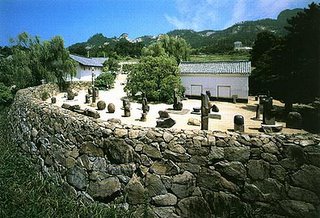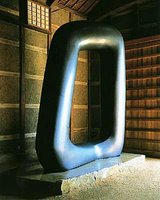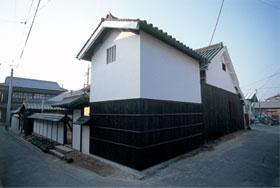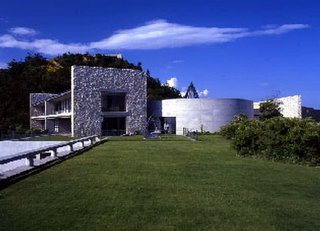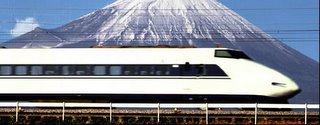A 16th C Garden and a 21st C Museum
Orginally written on December 27 , 2005
I made it through the night at the Shin Hankyu Hotel Annex, but switched to the Hilton for the rest of my stay in Osaka. When I worked at the British telephone carrier, C&W, I frequently stayed at Hilton hotels, so I am still a Gold member. They upgraded me to the 19th floor and threw in the gym and breakfast at no extra charge. All for just $20 more that I paid at the Shin Hankyu. Yeah, Conrad (and Paris) Hilton.
 I am now on the train bound for Kanazawa, home to the 21st Century Museum of Contemporary Art. I am not sure that the 21st C is quite ready for its own museum. But that is exactly what they said about “modern art” when MOMA was started in New York.
I am now on the train bound for Kanazawa, home to the 21st Century Museum of Contemporary Art. I am not sure that the 21st C is quite ready for its own museum. But that is exactly what they said about “modern art” when MOMA was started in New York.After checking in to the $70 a-night Kanazawa Miyako Hotel (just as dreadful as the Shin Hankyu, but at less than half the price...), I catch a taxi to Kenrokuen. This is one of Japan's top three gardens (reportedly, the best). The others are Korakuen in Okayama and one more that I can't remember. This garden (or park in western terms) and the nearby castle date to the mid-16th century. It was the private playground of the feudal Maeda clan until opened to commoners like me in 1871.
 As my guide babbles ceaselessly in JPN, I nod appreciatively, though I am only catching about every third word.
As my guide babbles ceaselessly in JPN, I nod appreciatively, though I am only catching about every third word.A light snow is falling so I open the white plastic umbrella that the hotel lent me. Supposedly, each season brings unique views and colors to the 28+ acres in this park. Of course this includes Sakura (cherry blossoms) in early spring—over 300 trees worth. December is no less dramatic.

From the first day of each November trees all over Kenrokuen (and around Kanazawa) are tied up with maypole-like poles and yuki-tsuri (snow rope) supports that protect them from the heavy, wet snow of this region. Annual rope tie bill: US$1.5 million.
The walk from Kenrokuen to the 21st C Museum takes just five minutes. Fifteen minutes later, having asked directions three times, I arrive at the one-story, circular glass-wall museum.
"The [current] exhibition, ‘Alternative Paradise,’ prepares a platform to discuss the value of koegi, literally ‘craft art,’ beyond any limit of genre classification,” says the museum brochure. Oh really? I won’t bore you (further) with their pained justification of the mish-mash of works represented here.
The past ten years have seen a boom in new museums and restorations. Perhaps, the most famous is architect Frank Gehry’s Guggenheim which opened in Bilbao, Spain in 1997. It showed the world and every local tourism authority that a well-designed museum—especially one with a world-class architect—could bring in the tourist dollars, yen and euros. Nonetheless, there has been a debate as to which is more important the museum or the art which occupies it.
Arguably, the exhibitions at the Bilbao Guggenheim are but accessories. Gehry’s masterpiece is the main event. Not so with the "21st C" designed by a JPN duo, Kazuyo Sejima and Ryue Nishizawa, under the tag SANAA. Under their skilled hands, this museum is a palate on which (often) young abstract artists can display their craft/art. The extensive use of floor-to-ceiling glass on all the exterior walls and many of the interior walls attempts challenge our notions of interior and exterior.
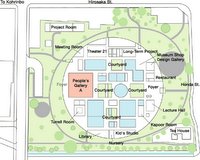 Before leaving NY, I had the privilege of living in a mid-century glass house. And for two years in Japan, I lived in a traditional Japan house whose outer walls could be removed leaving the house open to the garden. But this museum goes beyond that forced mediation between in and out. This museum is nude, exposed to all the elements and with rich rewards.
Before leaving NY, I had the privilege of living in a mid-century glass house. And for two years in Japan, I lived in a traditional Japan house whose outer walls could be removed leaving the house open to the garden. But this museum goes beyond that forced mediation between in and out. This museum is nude, exposed to all the elements and with rich rewards.Does it work as a building? Will the avant garde craft work currently on display stand the test of time and eventually be called art? Stay tuned.
